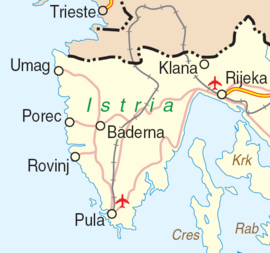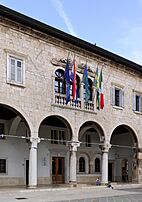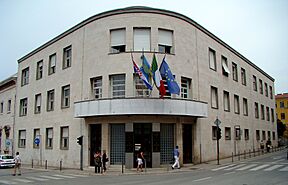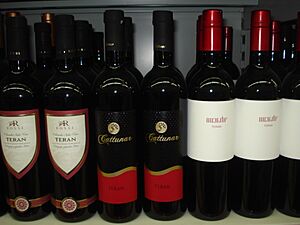Istria County facts for kids
Quick facts for kids
Istria County
|
|||
|---|---|---|---|
|
|||
| Anthem: Krasna zemljo (Croatian) "Beautiful land" |
|||
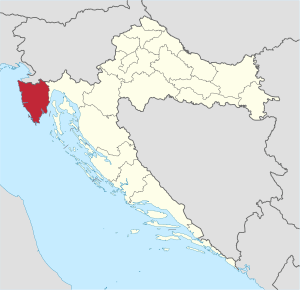
Istria County within Croatia
|
|||
| Country | Croatia | ||
| County seat Largest City |
Pazin Pula |
||
| Area | |||
| • Total | 2,813 km2 (1,086 sq mi) | ||
| Population
(2021)
|
|||
| • Total | 195,794 | ||
| • Density | 69.603/km2 (180.27/sq mi) | ||
| Languages | |||
| • Official languages | Croatian and Italian | ||
| Area code | 052 | ||
| ISO 3166 code | HR-18 | ||
| HDI (2021) | 0.875 very high · 3rd |
||
Istria County is a region in Croatia, located on the westernmost part of the Istrian peninsula. It is known for its beautiful coastline and rich history.
Its main cities are Pazin, Pula, and Poreč. Many people here speak Italian, making it the largest Italian-speaking area in Croatia. Istria County shares a border with Slovenia.
Contents
History of Istria County
Ancient Times and Early Settlements
The area of Istria has been home to people for a very long time. In caves near Pula, like Šandalja and Roumald's cave, scientists have found tools and remains from the Stone Age. This shows that people lived here thousands of years ago.
Later, around 1800 to 1000 BC, during the Bronze Age, many items like weapons, tools, and jewelry were made. These findings help us understand how people lived and what they used in their daily lives.
Roman Rule and Beyond
The ancient Romans called the Istrian peninsula terra magica, which means "magical land." The name "Istria" comes from the Histri, an ancient tribe who lived here. The Romans described them as fierce fighters. After two big battles, the Romans finally took control of the area in 177 BC.
After the fall of the Western Roman Empire in 476 AD, Istria was ruled by different groups. First, the Goths took over, then the Byzantines. Over the centuries, it was also controlled by the Lombards, Avars, and Franks during the time of Charlemagne.
Venetian and Austrian Influence
In 1267, the Republic of Venice took control of the western and southern coasts of Istria. This was a time of great growth and prosperity for the region. Many of Istria's major cities developed their unique architecture and culture during these centuries under Venetian rule. The eastern part of Istria, however, was controlled by the Habsburgs (the Austrian Empire).
In 1797, Napoleon's Treaty of Campo Formio gave Istria to the Austrians. Later, it briefly became part of France, but by 1815, the Congress of Vienna confirmed that Austria would keep Istria. This led to the formation of regional governments, and from 1861 to 1918, the regional Parliament was located in Poreč.
Modern History and Famous People
After World War I, Istria became part of Italy in 1920. However, after World War II, it was given to Yugoslavia. During this time, many Italian people living in Istria moved away. When Yugoslavia broke apart, Istria became part of independent Croatia. Luckily, the region did not experience any fighting during the Croatian War of Independence. Today, Istria is one of the most successful economic regions in Croatia.
Many famous people have lived or found inspiration in Istria. The scientist Robert Koch and writer James Joyce both worked here. The famous writer Jules Verne was inspired to write his novel Mathias Sandorf after hearing about a quarry and cave in Pazin. Even the poet Dante Alighieri visited Istria and wrote about it. Racing drivers Mario Andretti and Aldo Andretti were also born in Motovun, Istria.
Geography of Istria County
Istria County has a long coastline, stretching about 445 kilometers (277 miles). If you include the islands, it's even longer, at 539.9 kilometers (335.5 miles). A smaller part of the Istrian peninsula belongs to another Croatian county, Primorje-Gorski Kotar County. The region is close to the Julian Alps and faces the bay of Venice across the Adriatic Sea.
The westernmost point of Istria is at Savudrija, and the southernmost point is near Premantura, on a headland called Kamenjak.
Landscape and Natural Features
The land in Istria is mostly a limestone plateau. Much of it has a special type of landscape called karst topography, where water drains quickly through the rock, so there aren't many surface rivers. The highest point in Istria is Vojak on Učka mountain, which is 1,401 meters (4,596 feet) above sea level. There's also another mountain range called the Ćićarija.
People often talk about "white," "grey," and "red" Istria.
- White Istria refers to the areas around the mountain peaks.
- Grey Istria is the fertile land found further inland.
- Red Istria gets its name from the reddish soil called terra rossa or "crljenica" found near the coastline.
There are many interesting natural attractions. These include the Grotto of Baredine near Poreč, the underground river Pazinčica, and the Pazin pit (Pazinska jama) near Pazin. The Limski Kanal looks like a fjord, but it's actually a ria, which is a flooded river valley. The longest river in Istria is the Mirna, which is 32 kilometers (20 miles) long and flows into the sea near Novigrad. Other rivers include the Dragonja River and the Raša River.
Plants and Agriculture
The flat areas and valleys inland are mainly used for farming. Farmers grow things like cereals and vegetables. Closer to the sea, where the red soil is, they grow grapes for wine, olives, and figs. Agriculture, especially growing olives and making quality wines, is very important to Istria's economy.
The coastline and nearby islands are covered in maquis shrubland, which includes plants like holm oak and strawberry tree. Forests, mainly made up of oak and pine trees, cover about a third of the region.
Istria is also home to important natural protected areas. The Brijuni National Park and the Učka nature park are famous for their beautiful landscapes and wildlife. Other special places include Lim Bay, the forest near Motovun, and the protected area of Kamenjak in the far south. The Brijuni archipelago has about 680 different plant species and lovely olive groves.
Climate of Istria County
Istria has a pleasant Mediterranean climate. It is protected from cold northern winds by mountains, which helps keep the weather mild. Summers are usually warm during the day and cooler in the evening. The air is often humid, especially in coastal towns like Poreč, Rovinj, and Pula.
Temperatures stay above 10 °C (50 °F) for more than 240 days a year. The hottest month is August, with an average temperature of 24 °C (75 °F). January is the coldest, averaging 5 °C (41 °F). The Adriatic Sea here is also quite warm, reaching up to 26 °C (79 °F) in August.
There are two main winds in Istria:
- The bora brings cold, clear weather from the north in winter.
- The jugo is a southern wind that often brings rain in summer.
- The maestral is a gentle summer breeze that blows from the land towards the sea.
People of Istria County
| Historical populations of Istria County | ||
|---|---|---|
| Year | Pop. | ±% |
| 1857 | 117,719 | — |
| 1869 | 133,518 | +13.4% |
| 1880 | 160,000 | +19.8% |
| 1890 | 176,196 | +10.1% |
| 1900 | 194,455 | +10.4% |
| 1910 | 236,981 | +21.9% |
| 1921 | 215,167 | −9.2% |
| 1931 | 223,949 | +4.1% |
| 1948 | 183,344 | −18.1% |
| 1953 | 175,094 | −4.5% |
| 1961 | 176,838 | +1.0% |
| 1971 | 175,199 | −0.9% |
| 1981 | 188,332 | +7.5% |
| 1991 | 204,346 | +8.5% |
| 2001 | 206,344 | +1.0% |
| 2011 | 208,055 | +0.8% |
| 2021 | 195,794 | −5.9% |
| Source: Naselja i stanovništvo Republike Hrvatske 1857–2001, Croatian Bureau of Statistics, Zagreb, 2005 | ||
According to the 2021 census, about 195,794 people live in Istria County. This is about 4.8% of Croatia's total population. The county has about 70 people per square kilometer.
| population |
117719
|
133518
|
160000
|
176196
|
194455
|
236981
|
215167
|
223949
|
183344
|
175094
|
176838
|
175199
|
188332
|
204346
|
206344
|
208055
|
195794
|
| 1857 | 1869 | 1880 | 1890 | 1900 | 1910 | 1921 | 1931 | 1948 | 1953 | 1961 | 1971 | 1981 | 1991 | 2001 | 2011 | 2021 |
Istria County is divided into 41 local government areas. Ten of these are cities or towns, and 31 are smaller rural areas called municipalities. More than 70% of the people in Istria County live in these ten main cities:
- Pula / Pola (57,460 people)
- Poreč / Parenzo (16,696 people)
- Rovinj / Rovigno (14,294 people)
- Umag / Umago (13,467 people)
- Labin / Albona (11,642 people)
- Pazin / Pisino (8,638 people)
- Buzet / Pinguente (6,133 people)
- Vodnjan / Dignano (6,119 people)
- Buje / Buie (5,182 people)
- Novigrad / Cittanova (4,345 people)
There are also 31 municipalities, which are smaller towns and villages:
- Bale / Valle (1,127 people)
- Barban/ Barbana (2,721 people)
- Brtonigla / Verteneglio (1,626 people)
- Cerovlje / Cerreto (1,677 people)
- Fažana / Fasana (3,635 people)
- Gračišće / Gallignana (1,419 people)
- Grožnjan / Grisignana (736 people)
- Kanfanar / Canfanaro (1,543 people)
- Karojba / Caroiba (1,438 people)
- Kaštelir-Labinci / Castellier-Santa Domenica (1,463 people)
- Kršan / Chersano (2,951 people)
- Lanišće / Lanischie (329 people)
- Ližnjan / Lisignano (3,965 people)
- Lupoglav / Lupogliano (924 people)
- Marčana / Marzana (4,253 people)
- Medulin / Medolino (6,481 people)
- Motovun / Montona (1,004 people)
- Oprtalj / Portole (850 people)
- Pićan / Pedena (1,827 people)
- Raša / Arsia (3,183 people)
- Sveta Nedelja / Santa Domenica d'Albona (2,987 people)
- Sveti Lovreč / San Lorenzo di Pesenatico (1,015 people)
- Sveti Petar u Šumi / San Pietro di Selve (1,065 people)
- Svetvinčenat / Sanvincenti (2,202 people)
- Tar-Vabriga / Torre-Abrega (1,990 people)
- Tinjan / Antignana (1,684 people)
- Višnjan / Visignano (2,274 people)
- Vižinada / Visinada (1,158 people)
- Vrsar / Orsera (2,162 people)
- Žminj / Gimino (3,483 people)
- Funtana / Fontane (907 people)
Besides official Croatian, the Chakavian dialect of Croatian is often spoken. Italian is also an official language in the county.
In 2021, the main ethnic groups in Istria County were:
- Croats – 76.40%
- People identifying by regional affiliation – 5.13%
- Italians – 5.01%
- Serbs – 2.98%
- Bosniaks – 2.48%
- Albanians – 1.05%
Istria County was the first region in Croatia to join the Assembly of European Regions in 1994. This shows its strong connections with the rest of Europe.
Transportation in Istria County
Istria is well connected to the rest of Croatia and Europe by roads. The road system helps connect the coastal areas with the inland parts of Istria.
Railways
Historically, railways were built in Istria to support industries like shipbuilding and to serve Austrian military needs. A railway connecting Divača (in Slovenia) to Pula opened in 1876. There was also a narrow-gauge railway called Parenzana that connected the western parts of Istria, but it was taken apart in 1935. Today, Istria County's train connections are only towards Slovenia. To connect to the rest of Croatia's rail network, people use a bus service that goes through the Učka Tunnel.
Highways and Airport
Istria County has a modern highway system known as the "Istrian Y" because of its shape. The A8 motorway connects the county to the rest of Croatia through the Učka Tunnel. The A9 motorway connects Pula to Umag, linking Istria to Slovenia and Italy.
The main airport with regular flights is Pula Airport. Most flights are seasonal, meaning they operate only during certain times of the year, usually for tourism.
Economy of Istria County
Istria County has a strong economy. Important industries include:
- Processing industry: This involves making things from raw materials.
- Traditional agriculture: Farming is a big part of the economy.
- Sea fishing and growing: Fishing and seafood farming are important.
- Construction: Building homes and other structures.
- Production of construction materials: Making things like lime, cement, bricks, and stone.
- Trade and transport: Buying, selling, and moving goods.
Some of the most developed parts of industry are shipbuilding (the Uljanik shipyard used to build some of the biggest ships in the world), metal processing, wood and furniture making, and industries that make car parts, electrical machines, glass, plastic, and textiles.
Agriculture and Food Production
A lot of attention is given to agriculture and producing healthy, ecological food. Growing grapes for wine and olives for olive oil are very important. Istria is famous for its local wine varieties like Malvasia (white) and Teran (red).
Istrian olive growers have been recognized internationally. Since the 2000s, they have been included in the Flos Olei guide, which is a guide to the best extra virgin olive oils in the world. Istria has been named the world's best olive oil region by this guide for eight years in a row (2017-2024)!
Tourism in Istria County
Tourism in Istria has a long history. Even the ancient Romans enjoyed visiting, with Emperor Vespasian building the Pula Arena for entertainment. Later, during the Austro-Hungarian Empire in the late 1800s, Austrian and Hungarian royalty and wealthy families started visiting resorts like Poreč.
After World War II, a lot of effort was put into developing tourism. With its beautiful nature, rich history, and cultural sites, Istria has become a very popular place for visitors. The western coast, with towns like Poreč, Pula, Rovinj, Umag, Novigrad, and Vrsar, offers many great services for tourists.
A growing trend in central Istria, especially around Kanfanar, is agritourism. This allows visitors to stay on farms and experience the traditional Istrian agricultural lifestyle.
Istria is the most important tourist destination in Croatia. It welcomes many visitors from Western and Central Europe, especially from Germany, Slovenia, Austria, and Italy. About 27% of all visitors to Croatia come to Istria, and they spend about 35% of their total vacation time here.
Images for kids
See also
 In Spanish: Condado de Istria para niños
In Spanish: Condado de Istria para niños











